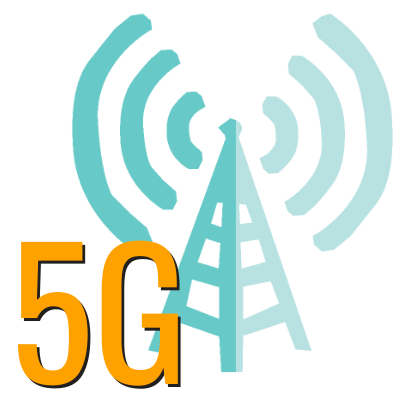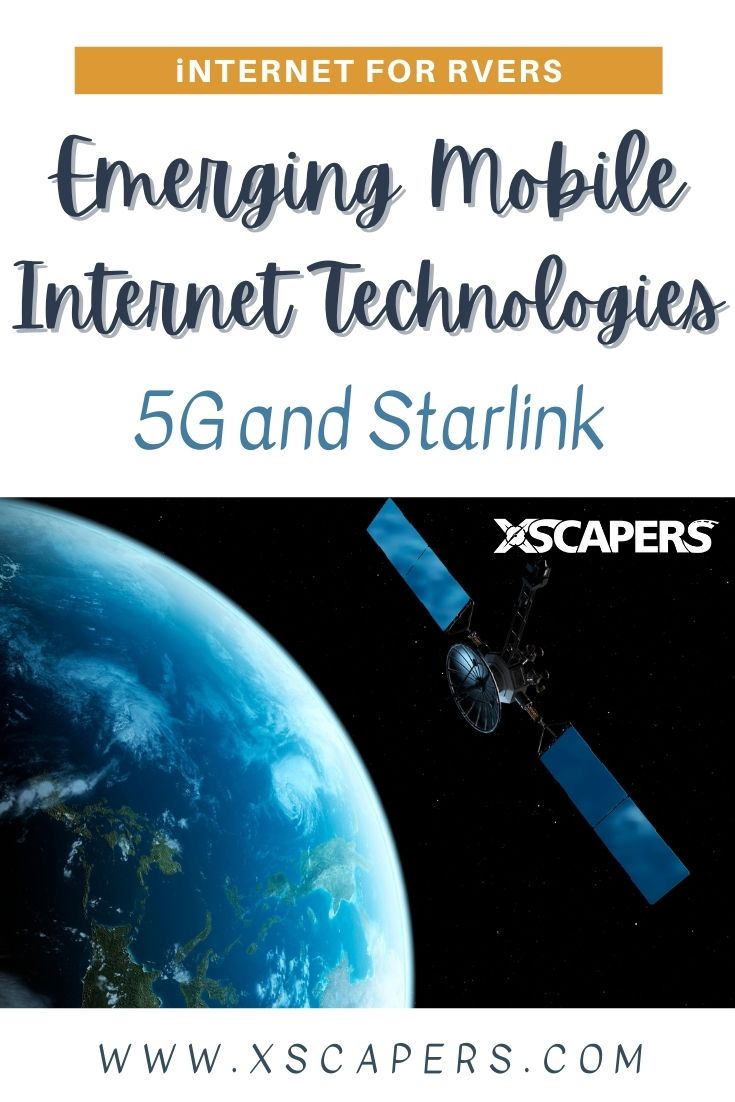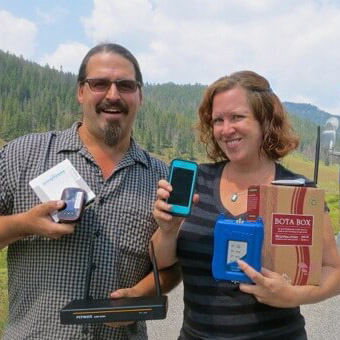5G & Starlink- Emerging Mobile Internet Technologies

Technology advances. It’s inherent to the definition of the word. It hasn’t stopped advancing, and it never will stop advancing. It’s exhausting. And also exciting.
You’re probably already familiar with some of the basic concepts used in mobile internet – primarily cellular data and using public Wi-Fi access points (for a recap of the options: Mobile Internet Overview). But what’s new and on the horizon in the world of mobile internet?
The two areas that are currently changing the most are concepts you’ve likely heard about: 5G cellular and mobile satellite internet.
5G Cellular
5G is shorthand for “fifth generation” cellular technology, just as 4G that dominated the last decade is for ‘fourth generation’. Though 5G technology has been available in an early form for a couple years now – it started to go mainstream in late 2020, and it will become as pervasive as 4G has been in the years ahead.
5G will allow for much faster peak speeds, substantially lower network latency, and far more capacity for massive amounts of data usage.
As 5G continues to roll out, it will lay the foundation for the next decade of evolution in cellular speeds and capabilities. But what exactly is 5G, and how will it impact nomads like RVers?

Types of 5G
All 5G is not created the same. There are actually three different frequency ranges that 5G will be broadcast on, with vastly different capabilities: Low, Mid, and High Band.
High-band 5G, or mmWave, is the best for speed. But these signals do not travel far through the air, and they can be easily blocked by walls and windows. This means that many of these mmWave 5G networks only provide 5G service within just a block or so (or even less) of the typically streetlight-mounted 5G transmitters.

High-band 5G is great for delivering service in places where a lot of people congregate – like stadiums, city centers, and shopping malls. It won’t be of much immediate importance for where RVers roam.
Low-band 5G, on the opposite end of the spectrum, travels much further. It will be able to reach everywhere that 4G/LTE is available today, providing 5G nationwide – even in rural locations. But it is essentially just “really good 4G” – with performance not likely to be dramatically different than what is possible today. This is the flavor of 5G that RVers are mostly likely to encounter in their remote wanderings.
Mid-band 5G will provide a good balance of speed and range – and will be the key to a truly “next generation” 5G experience. Mid-band spectrum however hasn’t been deployed much yet, and it will take time for the cellular networks to widely deploy mid-band networks. Mid-band coverage, while only reaching a few miles from a tower, will be encountered by RVers in large cities and small towns alike.
All the cellular carriers are working to eventually deploy all three types of 5G – but they are each focusing on different types of deployments first.
5G Gear
For a new generation of cellular technology, both the transmitting gear used by the carrier (the tower) and the receiving devices (your cell phones, hotspots or routers) need to be designed to operate under new 5G specifications in order to benefit from them.
5G gear will remain backward compatible with 4G networks, of course. 4G gear on the other hand will not be able to speak 5G. You will need to eventually buy new gear if you want to tap into the capabilities of 5G networks.
But since the networks will take time to fully evolve, it makes sense to avoid investing in 5G gear too early – before the networks are ready.
Unless you’re someone who always wants to have the latest and greatest equipment, there’s probably no need to rush to upgrade equipment like routers and hotspots. External antennas are already on the market that can be a great way to futureproof now, and current cellular boosters will have limited use in a 5G world.
And there’s certainly no reason to avoid purchasing 5G compatible smartphones if you’re in the market for new consumer products now.
For more information on 5G and our coverage, see: 5G Cellular Resources

Mobile Satellite Internet
Another hot topic in the mobile internet world lately is Starlink – the satellite broadband division of SpaceX, an Elon Musk founded company. Unlike current geostationary satellite internet options, Starlink utilizes a constellation of low-earth-orbit (LEO) satellites that is intended to provide redundant, high-speed, low-latency, global internet coverage in the future.
The advantage of having satellites at lower orbits is that they are physically close enough to users on the ground to provide fast low-latency communications rivaling 4G and 5G cellular speeds.
Will Starlink Work for RVers?
Some RVers and cruisers are already dreaming of ditching their cellular plans and gear, hoping that Starlink will be able to deliver on the dream of coverage everywhere they go.
And in the future, Starlink will likely make satellite a viable component of an RVers mobile internet setup, perhaps even a primary way online for many.
There will be challenges for RVers using Starlink however, at least initially; including equipment, coverage, clear open sky requirements and potential congestion issues in populated areas.
There will simply be places where Starlink will not be ideal because local terrain, trees or buildings blocking view of the passing over satellites, or there is not enough capacity in an area. Cellular will likely remain a strong component of a mobile internet setup for most RVers, even as Starlink is fully deployed and mobile.
While Starlink has filed for systems that can be used while in motion, that is not yet approved by the FCC – but once there is adequate nationwide coverage, most RVers will likely be content with just being able to dynamically change their service address as they setup in new locations.
Availability and Pricing of Starlink
The Starlink system is still currently being launched into orbit and there should be minimal nationwide coverage & capacity by the end of 2021.
A public beta-test began rolling out in late October of 2020 in northern areas for fixed (non-mobile) location applications, and the area included in the beta is slowly expanding southward as the constellation fills out.
The Starlink user terminal (packaged with a basic tripod mount and a companion indoor Wi-Fi router) costs $499. Monthly fixed residential subscription costs are set at $99/mo, and currently allow for unlimited data. What we don’t know yet is if mobile systems and service will have similar pricing.
For more information on mobile internet satellite, including our coverage on other competing LEO systems from OneWeb and Amazon, follow up at Mobile Satellite Internet Resouces.
There are a lot of exciting things happening in the mobile world. But both 5G and low-earth satellite technologies are still being developed and rolled out, so neither has reached their potential yet.
At the Mobile Internet Resource Center we are constantly tracking updates and developments on both and helping our audience decide when is the right time to jump onboard and plan their current mobile internet strategy with the future in mind.
Did you like this post? Pin it on Pinterest!


Authors
Cherie Ve Ard and Chris Dunphy
Cherie Ve Ard and Chris Dunphy are the co-founders of the Mobile Internet Resource Center, which provides unbiased information, reviews, resources and tutorials to help us all stay better connected on the road. They have been living and working full-time on the road since 2006, blogging about their travels on Technomadia.com. Internet connectivity has been essential to them every step of the way.

 Previous Post
Previous Post Next Post
Next Post
[…] Xscaper’s Blog: 5G & Starlink- Emerging Mobile Internet Technologies […]